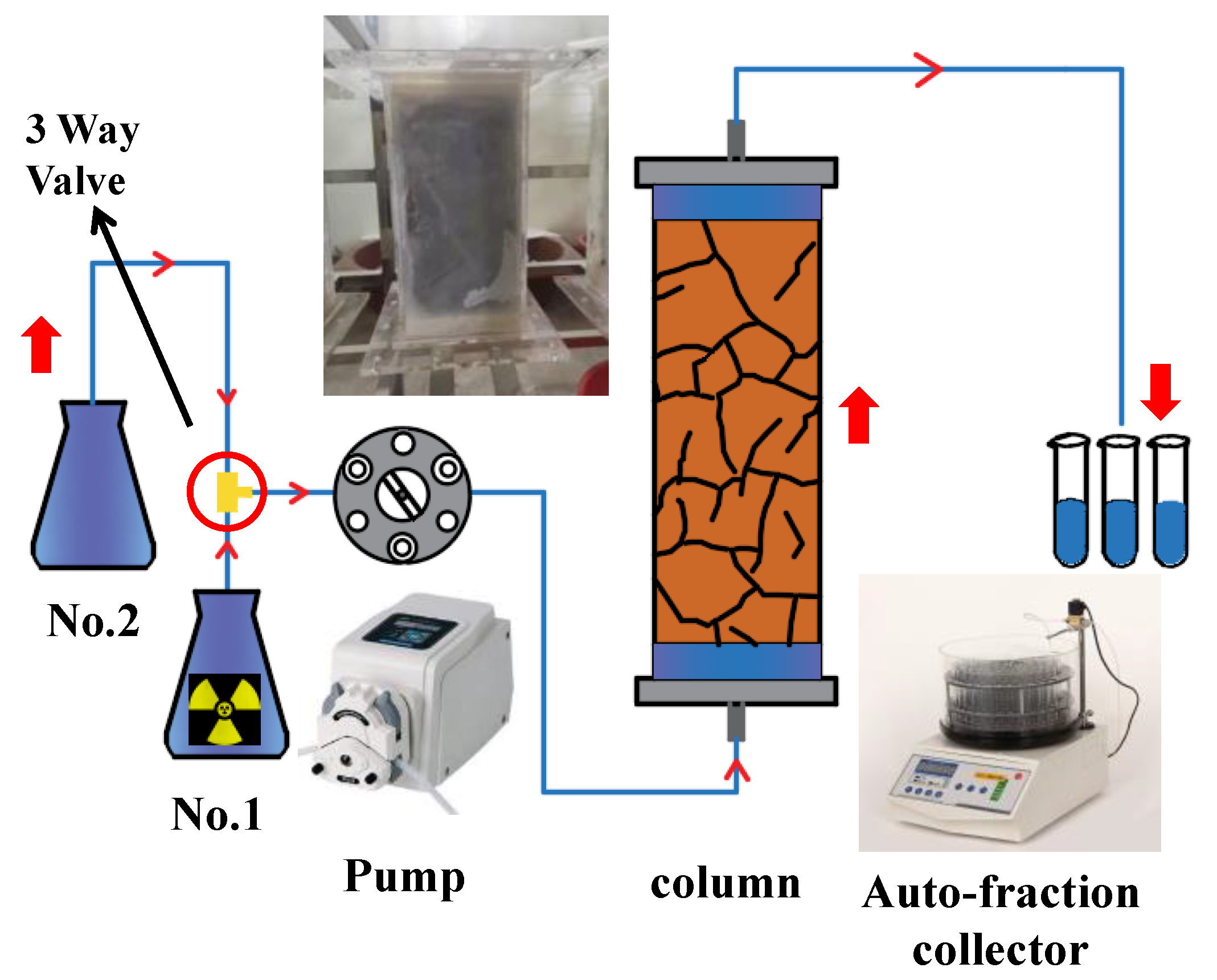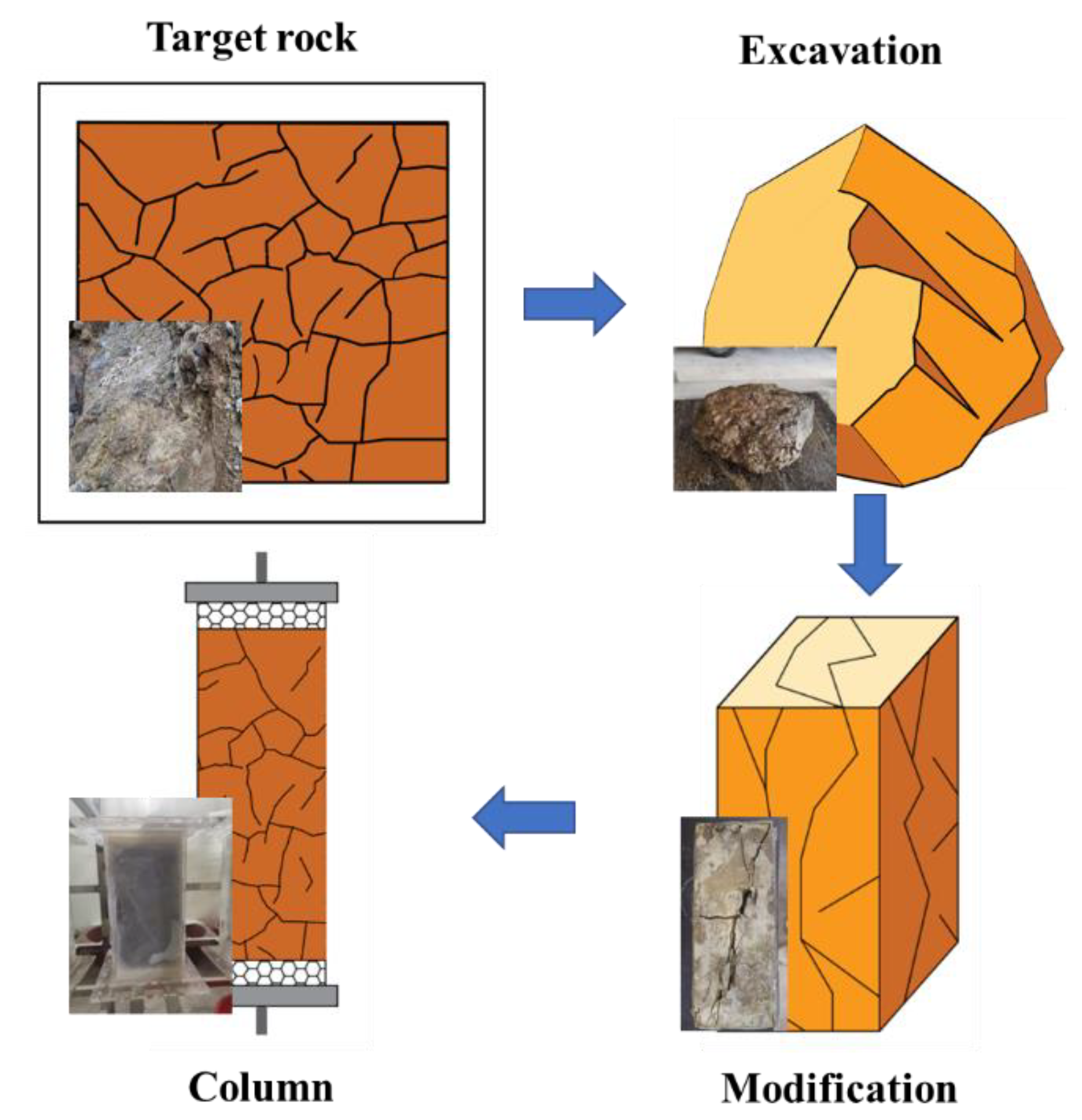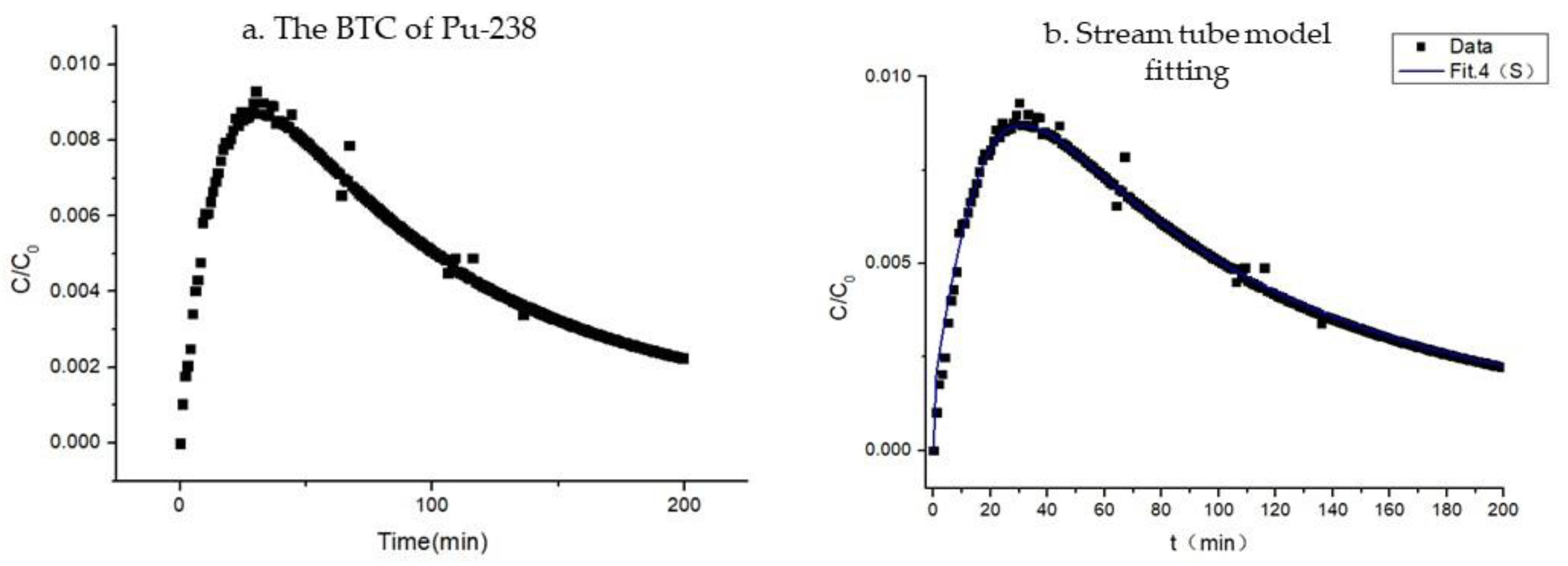Advection–Dispersion Behavior for Simulation of H-3 and Pu-238 Transport in Undisturbed Argillaceous Shale of a Near-Surface Repository
Abstract
1. Introduction
2. Theory of Advection and Dispersion
2.1. Equivalent Porous Medium Model
2.2. Two-Region Nonequilibrium Model
2.3. Stream Tube Model
3. Experiment
3.1. Experimental Device
3.2. Field Sample
3.3. Analysis of Argillaceous Shale and Groundwater
3.4. Batch Sorption Test
3.5. Water Saturation
3.6. Nonreactive Tests—H-3
3.7. Reactive Tests—Pu-238
3.8. Mathematical Model and Parameter Estimations
4. Results and Discussion
4.1. Breakthrough Curves of H-3
4.2. Breakthrough Curves of Pu-238
4.3. Parameter Comparison
5. Conclusions
- The advection–dispersion behavior of H-3 and Pu-238 in the highly weathered argillaceous shale showed “preferential flow”, reflecting the strong heterogeneity of highly weathered argillaceous shale.
- The equilibrium model, the nonequilibrium model (in the two-region mode), and the stream tube model were used to fit the BTC. The results show that the stream tube model can better fit the curve characteristics, indicating that the water-carrying capacity of each channel of media varies greatly and is complex.
- A comparison of the distribution coefficients obtained from the column and batch experiments indicated that the distribution coefficient obtained from the column experiment was smaller, and an analysis was necessary mainly due to the contact area and contact time.
Author Contributions
Funding
Institutional Review Board Statement
Informed Consent Statement
Data Availability Statement
Acknowledgments
Conflicts of Interest
References
- Zheng, J.-M.; Yin, J.-P.; Chen, H.; Wang, F.-L.; Guo, Y.-F.; Guo, X. Current Status of Foreign Radioactive Waste Management. Nucl. Electron. Detect. Technol. 2021, 41, 821–827. [Google Scholar]
- International Atomic Energy Agency. Contents and Sample Arguments of a Safety Case for Near Surface Disposal of Radioactive Waste; IAEA-TECDOC-1814; IAEA: Vienna. Austria, 2017. [Google Scholar]
- International Atomic Energy Agency. The Safety Case and Safety Assessment for the Disposal of Radioactive Waste; IAEA Safety Standards Series No.SSG-23; IAEA: Vienna, Austria, 2012. [Google Scholar]
- International Atomic Energy Agency. Near Surface Disposal Facilities for Radioactive Waste; IAEA Safety Standards Serie No. SSG-29; IAEA: Vienna, Austria, 2014. [Google Scholar]
- Pan, Z.-Q.; Qian, Q.-H. Study on Geological Disposal Strategy of High-Level Radioactive Waste; Atomic Energy Press: Beijing, China, 2009. [Google Scholar]
- Zhang, L.-M.; Zhou, Y.; Yue, J.-G. Causes and Regulation Measures of Landslide on High Slope of Feifengshan Low and Medium Level Solid Waste Disposal Site. Sci. Technol. Eng. 2020, 20, 942–949. [Google Scholar]
- Smith, D.K.; Finnegan, D.L.; Bowen, S.M. An inventory of long-lived radionuclides residual from underground nuclear testing at the Nevada test site, 1951–1992. J. Environ. Radioact. 2003, 67, 35–51. [Google Scholar] [CrossRef] [PubMed]
- Woodhead, D. The Radiological Situation at the Atolls of Mururoa and Fangataufa. J. Radiol. Prot. 1999, 19, 194. [Google Scholar] [CrossRef]
- Wang, X.; Liu, C.; Wang, C.; Li, C.; Chen, T. Adsorption and diffusion of some important radionuclides in Beishan granites and Gaomiaozi Bentonites. Sci. Sin. Chim. 2020, 50, 1585–1599. [Google Scholar] [CrossRef]
- Tian, X.I.E.; Chao, C.H.E.N.; Jun, Z.H.U.; Yun-feng, S.H.I.; Ting, L.I.; Ai-ming, Z.H.A.N.G. Adsorption and Kinetics of Uranium, Plutonium and Other Nuclides on Geotechnical Media. J. Nucl. Radiochem. 2021, 43, 353–361. [Google Scholar]
- Haijun, D.; Xiaolin, H.; Wenyuan, L.; Chong LI, U.; Jiang, X.U. Diffusivity of /Sr, I and Pu in Granite with Through-Diffusion Experiment. J. Nucl. Radiochem. 2014, 36, 53–59. [Google Scholar]
- Deng, X.; Tuo, X.; Li, Z.; Leng, Y.; Tian, Q.; Huang, H. Experimental simulation of 238U and 239Pu migration speed in shale and soil medium. Environ. Chem. 2012, 31, 1948–1952. [Google Scholar]
- Chao, C.; Jun, Z.; Aiming, Z.H.A.N.G. The adsorption transfer mechanism of U and 238Pu in sandy aquifers. Nucl. Tech. 2019, 42, 1–9. [Google Scholar]
- Li, Y.; Zhang, A.; Chen, H.; Lian, B.; Zhao, Y. Migration Experiment of 238Pu in Sandy Soil in Vadose Zone of Chinese Arid Area. Environ. Sci. Technol. 2017, 40, 97–99. [Google Scholar]
- Palágyi, Š.; Štamberg, K.; Vopálka, D. A simplified approach to evaluation of column experiments as a tool for determination of radionuclide transport parameters in rock-groundwater or soil-groundwater systems. J. Radioanal Nucl. Chem. 2015, 304, 945–954. [Google Scholar] [CrossRef]
- Palágyi, S.; Štamberg, K. Transport parameters of I- and IO3-determined in crushed rock column and groundwater system under dynamic flow conditions. J. Radioanal Nucl. Chem. 2014, 302, 647–653. [Google Scholar] [CrossRef]
- Lee, C.-P.; Chen, D.; Hu, Y.; Jan, Y.-L.; Shi, Y.; Wang, Z.; Wu, E.; Tien, N.-C.; Sun, Y.; Tsai, S.-C. An Application of Safety Assessment for Radioactive Waste Repository: Non-Equilibrium Transport of Tritium, Selenium, and Cesium in Crushed Granite with Different Path Lengths. Appl. Sci. 2021, 11, 9750. [Google Scholar] [CrossRef]
- Shi, Y.; Lee, C.P.; Yu, H.; Hu, Y.; Liu, H.; Tien, N.C.; Wang, Y.; Liu, W.; Kong, J.; Hua, R.; et al. Study on advection–dispersion behavior for simulation of HTO and Se transport in crushed granite. J. Radioanal. Nucl. Chem. 2021, 328, 1329–1338. [Google Scholar] [CrossRef]
- Shi, Y.; Yang, S.; Chen, W.; Xiong, W.; Zhang, A.; Yu, Z.; Lian, B.; Lee, C.-P. Study on Tritium and Iodine Species Transport through Porous Granite: A Non-Sorption Effect by Anion Exclusion. Toxics 2022, 10, 540. [Google Scholar] [CrossRef] [PubMed]
- Zhang, X.; Ma, F.; Dai, Z.; Wang, J.; Chen, L.; Ling, H.; Soltanian, M.R. Radionuclide Transport in Multi-scale Fractured Rocks: A Review. J. Hazard. Mater. 2022, 424, 1–23. [Google Scholar] [CrossRef] [PubMed]
- Hadgu, T.; Karra, S.; Kalinina, E.; Makedonska, N.; Hyman, J.D.; Klise, K.; Viswanathan, H.S.; Wang, Y. A comparative study of discrete fracture network and equivalent continuum. models for simulating flow and transport in the far field of a hypothetical nuclear waste repository in crystalline host rock. J. Hydrol. 2017, 553, 59–70. [Google Scholar] [CrossRef]
- Jackson, C.P.; Hoch, A.R.; Todman, S. Self-consistency of a heterogeneous continuum porous medium representation of a fractured medium. Water Resour. Res. 2000, 36, 189–202. [Google Scholar] [CrossRef]
- Blessent, D.; Jørgensen, P.R.; Therrien, R. Comparing Discrete Fracture and Continuum Models to Predict Contaminant Transport in Fractured Porous Media. Groundwater 2014, 52, 84–95. [Google Scholar] [CrossRef] [PubMed]
- Reimus, P.; Pohll, G.; Mihevc, T.; Chapman, J.; Haga, M.; Lyles, B.; Kosinski, S.; Niswonger, R.; Sanders, P. Testing and parameterizing a conceptual model for solute transport in a fractured granite using multiple tracers in a forced-gradient test. Water Resour. Res. 2003, 39, 1–15. [Google Scholar] [CrossRef]
- Takeno, N. Atlas of Eh-pH Diagrams Intercomparison of Thermodynamic Databases, Geological Survey of Japan Open File Report No.419; National Institute of Advanced Industrial Science and Technology Research Center for Deep Geological Environments: Tokyo, Japan, 2005. [Google Scholar]




| Item | Location | Length × Width × Height (cm) | Weight (g) | Density (g/cm3) | Porosity |
|---|---|---|---|---|---|
| Argillaceous shale | Near-surface repository in China | 36 × 12 × 12 | 12.39 ± 0.50 | 2.39 ± 0.05 | 0.18 ± 0.03 |
| Item | SiO2 (%) | Al2O3 (%) | Fe2O3 (%) | MgO (%) | CaO (%) | Na2O (%) |
|---|---|---|---|---|---|---|
| Argillaceous shale | 60.02 | 17.50 | 6.89 | 2.06 | 0.516 | 0.740 |
| K2O (%) | MnO (%) | TiO2 (%) | P2O5 (%) | Loss on ignition (%) | FeO (%) | |
| 3.90 | 0.09 | 0.699 | 0.111 | 7.42 | 1.11 | |
| Sr (μg/L) | Ni (μg/L) | Pu (ppm) | Organic matter (g/kg) | Cation exchange capacity (cmol/kg) | ||
| 85.3 | 41.6 | 1 | 22.1 | 21.5 | ||
| Item | Dolomite | Calcite | Quartz | Plagioclase | Potash Feldspar |
|---|---|---|---|---|---|
| Argillaceous shale | 8 | - | 28 | 5 | - |
| Illite | Amphibole | Chlorite | Pyrite | Montmorillonite | |
| 31 | - | 2 | - | 26 |
| Item | F− | Cl− | NO3− | SO42− | Na+ | K+ | Mg2+ | Ca2+ |
|---|---|---|---|---|---|---|---|---|
| Groundwater | (mg/L) | |||||||
| 0.487 | 1.82 | 2.23 | 42.9 | 24.3 | 14.5 | 2.89 | 19.1 | |
| Sr | Ni | Pu | Conductivity | pH | Turbidity (UNT) | |||
| μg/L | ppm | μS/cm | ||||||
| 257 | 1.1 | <1 | 271 | 8.19 | 0.43 | |||
| NO | Model | v (cm/min) | D (cm2/min) | Kd (L/kg) | β | a | RMSE | ||
|---|---|---|---|---|---|---|---|---|---|
| FIT1 (H-3) | Equilibrium | 0.026 | 19.812 | 0 | - | - | 0.930 | ||
| FIT2 (H-3) | Two-region non-equilibrium | 0.426 | 17.514 | 0 | 0.191 | 0.832 | 0.987 | ||
| NO | model | <v> (cm/min) | <D> (cm2/min) | <Kd> (L/kg) | σV | σD | σKd | RMSE | |
| FIT3 (H-3) | Stream tube | 0.490 | 0.292 | 0 | 1.111 | 3.120 | 0 | 0.996 | |
| FIT4 (238Pu) | Stream tube | 0.490 | 0.292 | 46.924 | 1.111 | 3.120 | 38.512 | −1 | 0.957 |
Disclaimer/Publisher’s Note: The statements, opinions and data contained in all publications are solely those of the individual author(s) and contributor(s) and not of MDPI and/or the editor(s). MDPI and/or the editor(s) disclaim responsibility for any injury to people or property resulting from any ideas, methods, instructions or products referred to in the content. |
© 2023 by the authors. Licensee MDPI, Basel, Switzerland. This article is an open access article distributed under the terms and conditions of the Creative Commons Attribution (CC BY) license (https://creativecommons.org/licenses/by/4.0/).
Share and Cite
Shi, Y.; Yang, S.; Wu, E.; Wang, L.; Chen, W.; Xiong, W.; Zhang, Y.; Zhang, A.; Lian, B. Advection–Dispersion Behavior for Simulation of H-3 and Pu-238 Transport in Undisturbed Argillaceous Shale of a Near-Surface Repository. Toxics 2023, 11, 124. https://doi.org/10.3390/toxics11020124
Shi Y, Yang S, Wu E, Wang L, Chen W, Xiong W, Zhang Y, Zhang A, Lian B. Advection–Dispersion Behavior for Simulation of H-3 and Pu-238 Transport in Undisturbed Argillaceous Shale of a Near-Surface Repository. Toxics. 2023; 11(2):124. https://doi.org/10.3390/toxics11020124
Chicago/Turabian StyleShi, Yunfeng, Song Yang, Enhui Wu, Longjiang Wang, Wenjie Chen, Weijia Xiong, Yanna Zhang, Aiming Zhang, and Bing Lian. 2023. "Advection–Dispersion Behavior for Simulation of H-3 and Pu-238 Transport in Undisturbed Argillaceous Shale of a Near-Surface Repository" Toxics 11, no. 2: 124. https://doi.org/10.3390/toxics11020124
APA StyleShi, Y., Yang, S., Wu, E., Wang, L., Chen, W., Xiong, W., Zhang, Y., Zhang, A., & Lian, B. (2023). Advection–Dispersion Behavior for Simulation of H-3 and Pu-238 Transport in Undisturbed Argillaceous Shale of a Near-Surface Repository. Toxics, 11(2), 124. https://doi.org/10.3390/toxics11020124







